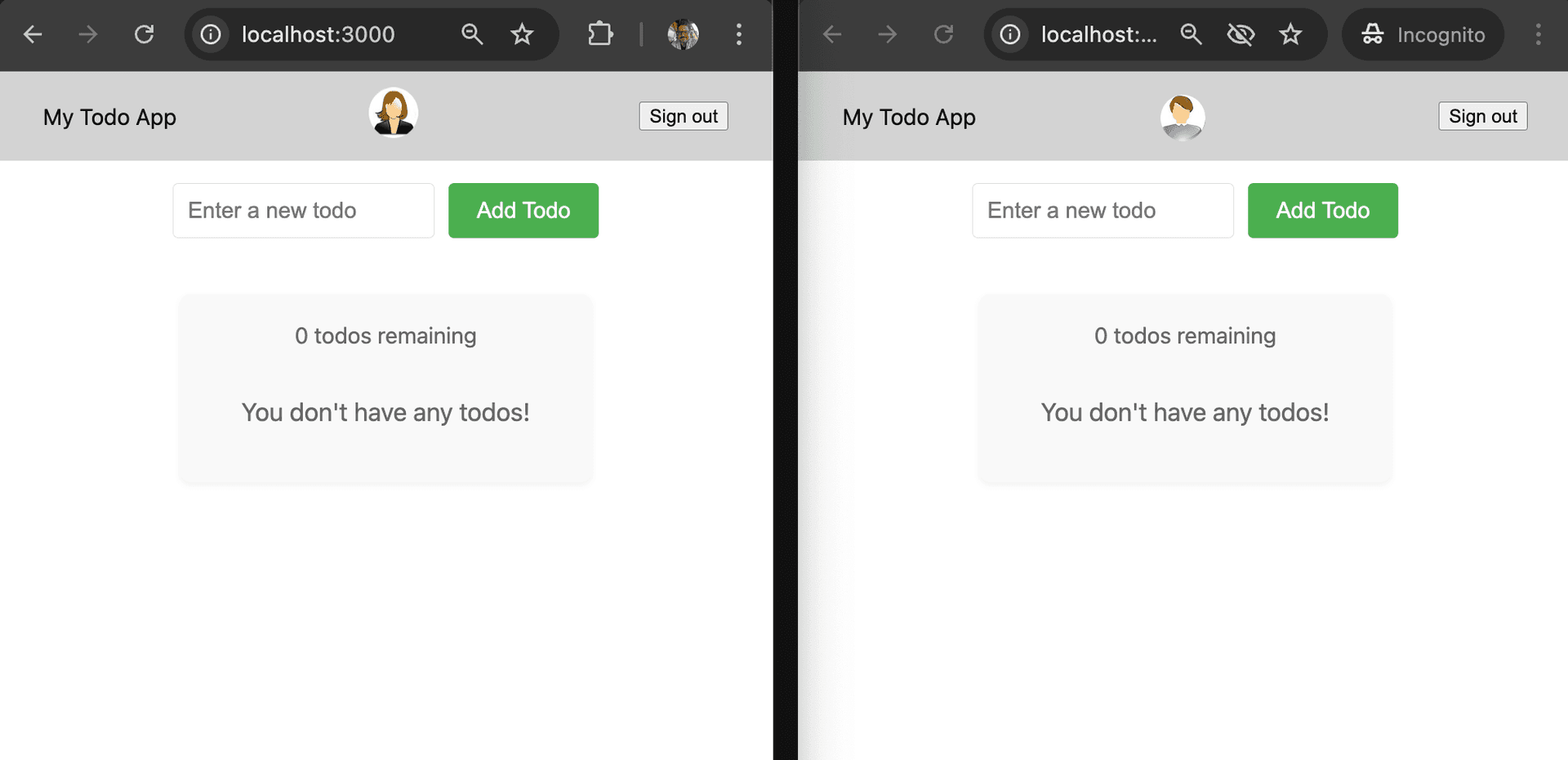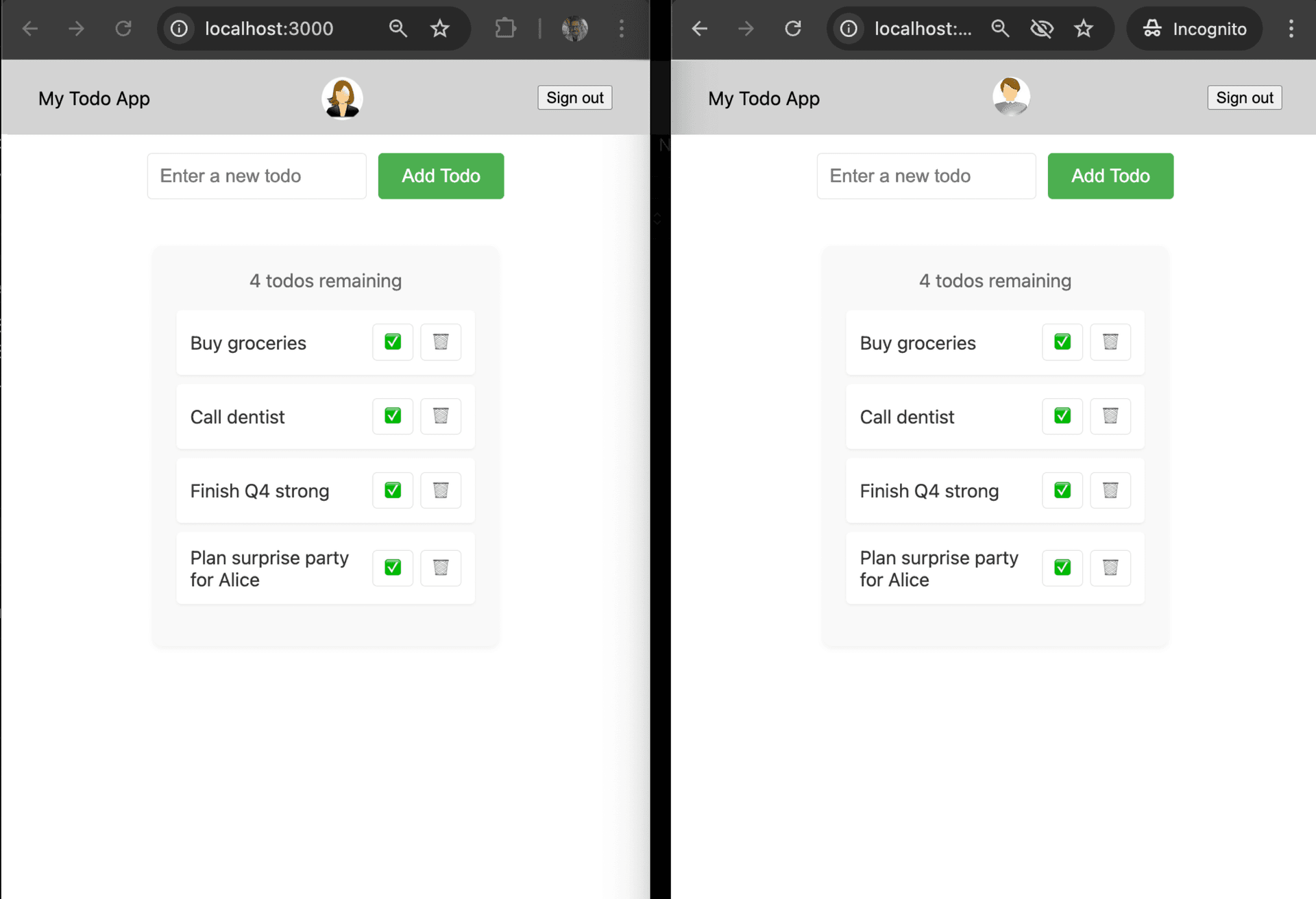Neon Authorize tutorial
Learn how Row-level Security (RLS) protects user data
Sample project
In this tutorial, you’ll set up a sample todos application to learn how Postgres Row-Level Security (RLS) policies can protect user data, adding an extra layer of security beyond application logic.
About the sample application
This todos app is built with Next.js and Drizzle ORM, using Clerk for user authentication and session management. Clerk handles logins and issues a unique userId in a JSON Web Token (JWT) for each authenticated user. This userId is then passed to Postgres, where RLS policies enforce access control directly in the database. This setup ensures that each user can only interact with their own todos, even if application-side logic fails or is misconfigured.
Prerequisites
To get started, you’ll need:
-
Neon account: Sign up at Neon and create your first project in AWS (note: Azure regions are not currently supported).
-
Clerk account: Sign up for a Clerk account and application. Clerk provides a free plan to get you started.
-
Neon Authorize + Clerk example application: Clone the sample Clerk + Neon Authorize repository:
git clone https://github.com/neondatabase-labs/clerk-nextjs-neon-authorize.gitFollow the instructions in the readme to set up Clerk, configure environment variables, and start the application. You can also find more info in our Clerk and Neon Authorize Quickstart.
Step 1 — Create test users
Start the sample application:
npm run devOpen the app in your browser using localhost:3000.
Now, let's create the two users we'll use to show how RLS policies can prevent data leaks between users, and what can go wrong if you don't. The sample app supports Google and email logins, so let's create one of each. For this guide, we'll call our two users Alice and Bob.
Create your Alice user using Google. Then, using a private browser session, try the email sign-up to create Bob. You'll receive a verification email from MyApp, probably in your spam folder.
Side by side, here's the empty state for both users:

When each user creates a todo, it’s securely linked to their userId in the database schema. Here’s the structure of the todos table:
{
id: bigint("id", { mode: "bigint" })
.primaryKey()
.generatedByDefaultAsIdentity(),
userId: text("user_id")
.notNull()
.default(sql`(auth.user_id())`),
task: text("task").notNull(),
isComplete: boolean("is_complete").notNull().default(false),
insertedAt: timestamp("inserted_at", { withTimezone: true })
.defaultNow()
.notNull(),
}The userId column is populated directly from the authenticated (auth.user_id()) in the Clerk JWT, linking each todo to the correct user.
Step 2 — Create todos
Let's create some sample Todos for both Alice and Bob.

Todos are isolated
In this sample app, isolation of Todos to each user is handled both in the application logic and using Row-level Security (RLS) policies defined in our application's schema file.
Let's take a look at the getTodos function in the actions.tsx file:
export async function getTodos(): Promise<Array<Todo>> {
return fetchWithDrizzle(async (db, { userId }) => {
// WHERE filter is optional because of RLS. But we send it anyway for
// performance reasons.
return db
.select()
.from(schema.todos)
.where(eq(schema.todos.userId, sql`auth.user_id()`))
.orderBy(asc(schema.todos.insertedAt));
});
}The WHERE clause is technically enough to make sure data is properly isolated. Neon gets auth.user_id from the Clerk JWT and matches that to the userId column in the todos tables, so each user can only see their own Todos.
Even though isolation is backed by our RLS policies, we include it here for performance reasons: it helps Postgres build a better query plan and use indexes where possible.
RLS policy for viewing todos
In the application's schema.ts file, you can find the RLS policies written in Drizzle that provide access control at the database level. Here is a look at one of those policies:
pgPolicy('view todos', {
for: 'select',
to: 'authenticated',
using: sql`(select auth.user_id() = user_id)`,
});This policy ensures that each SELECT query only returns rows where the user_id matches the auth.user_id() derived from the authenticated user’s JWT. This means that users can only access their own Todos. By enforcing this rule at the database level, the RLS policy provides an extra layer of security beyond the application layer.
Step 3 — Remove access control from application code
Now, let's test what happens when we remove access control from the application layer to rely solely on RLS at the database level.
In the getTodos function in actions.tsx, comment out the WHERE clause that filters todos by userId:
export async function getTodos(): Promise<Array<Todo>> {
return fetchWithDrizzle(async (db, { userId }) => {
// WHERE filter is optional because of RLS. But we send it anyway for
// performance reasons.
return (
db
.select()
.from(schema.todos)
// .where(eq(schema.todos.userId, sql`auth.user_id()`))
.orderBy(asc(schema.todos.insertedAt))
);
});
}Check your two open Todo users, reload the page, and see what happens:

Nothing happens. RLS is still in place, and isolation is maintained: no data leaks. 💪
Step 4 — Disable RLS
Let's see what happens when we disable RLS on our todos table. Go to your Clerk project in the Neon Console and in the SQL Editor run:
ALTER TABLE public.todos DISABLE ROW LEVEL SECURITY;
Bob sees all of Alice's todos, and Alice now knows about her birthday party. Disabling RLS removed all RLS policies, including the view todos policy on SELECT queries that helped enforce data isolation. Birthday surprise is ruined.
Step 5 — RLS as a safety net
Another scenario, imagine a team member writes the getTodos function like this, thinking it's filtering todos by the current user:
export async function getTodos(): Promise<Array<Todo>> {
return fetchWithDrizzle(async (db) => {
const todos = await db
.select()
.from(schema.todos)
.where(eq(schema.todos.userId, schema.todos.userId)) // Woops
.orderBy(asc(schema.todos.insertedAt));
return todos;
});
}The where clause here might look like a valid comparison, and in a busy review, it might even go unnoticed. The developer likely intended to compare schema.todos.userId to an authenticated userId, like schema.session.userId. But userId = userId is a tautology, and will always evaluate to true.
Go ahead and replace the getTodos in actions.tsx with this incorrect version. Referesh your open Todo pages and you'll see all todos still showing for both user sessions, as expected.
Re-enable RLS
Now, let's re-enable RLS from Neon:
ALTER TABLE public.todos ENABLE ROW LEVEL SECURITY;
With RLS back on, there are no more data leaks, despite the incorrect check on the application side. In this case, RLS acts as a backstop, preventing unintended data exposure due to application-side mistakes.
Order is restored, thanks to RLS. Now go fix your app before you forget:
export async function getTodos(): Promise<Array<Todo>> {
return fetchWithDrizzle(async (db, { userId }) => {
// WHERE filter is optional because of RLS. But we send it anyway for
// performance reasons.
return db
.select()
.from(schema.todos)
.where(eq(schema.todos.userId, sql`auth.user_id()`))
.orderBy(asc(schema.todos.insertedAt));
});
}Appendix: Understanding RLS policies in Drizzle
In this section, we provide an overview of the Row-Level Security (RLS) policies implemented in the todos application, found in the schema.ts file.
These policies are written in Drizzle, which now supports defining RLS policies alongside your schema in code. Writing RLS policies can be complex, so we worked with Drizzle to develop the crudPolicy function – a wrapper that works with Neon’s predefined roles (authenticated and anonymous), letting you consolidate all policies that apply to a given role into a single function. See Row-level Security in the Drizzle docs for details.
The examples here use pgPolicy for custom control over each action.
create todos
p1: pgPolicy("create todos", {
for: "insert",
to: "authenticated",
withCheck: sql`(select auth.user_id() = user_id)`,
}),This policy allows authenticated users to perform INSERT operations only if the user_id matches the auth.user_id() from the JWT. This ensures that when a new todo is created, it is linked to the correct user.
view todos
p2: pgPolicy("view todos", {
for: "select",
to: "authenticated",
using: sql`(select auth.user_id() = user_id)`,
}),This policy allows authenticated users to perform SELECT operations where the user_id matches the auth.user_id() from the JWT, ensuring they only see their own todos.
update todos
p3: pgPolicy("update todos", {
for: "update",
to: "authenticated",
using: sql`(select auth.user_id() = user_id)`,
}),This policy permits authenticated users to perform UPDATE operations on todos only if the user_id matches their authenticated user_id. This protects against unauthorized modifications.
delete todos
p4: pgPolicy("delete todos", {
for: "delete",
to: "authenticated",
using: sql`(select auth.user_id() = user_id)`,
}),This policy enables authenticated users to perform DELETE operations on their todos only if the user_id corresponds to their auth.user_id(). This ensures that users can only remove their own entries.
These policies are designed to enforce that only the authenticated user can create, view, update, or delete their own todos, thereby maintaining secure data access within the application.
RLS policies table
To check out the RLS policies defined for the todos table in Postgres, run this query:
SELECT * FROM pg_policies WHERE tablename = 'todos';Here is the output, showing columns policyname, cmd, qual, with_check only:
policyname | cmd | qual | with_check
--------------+--------+--------------------------------------------+--------------------------------------------
create todos | INSERT | | ( SELECT (auth.user_id() = todos.user_id))
update todos | UPDATE | ( SELECT (auth.user_id() = todos.user_id)) |
delete todos | DELETE | ( SELECT (auth.user_id() = todos.user_id)) |
view todos | SELECT | ( SELECT (auth.user_id() = todos.user_id)) |
(4 rows)